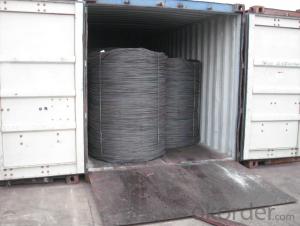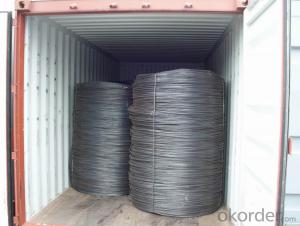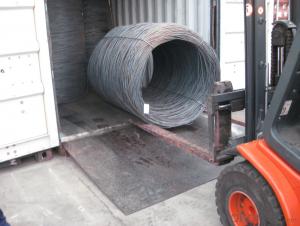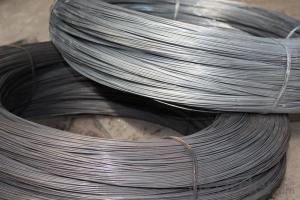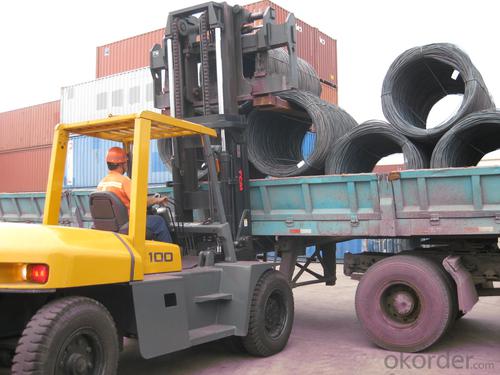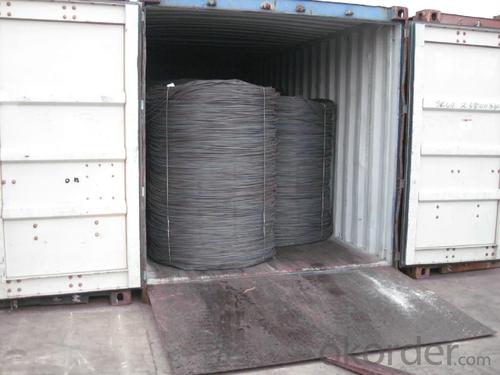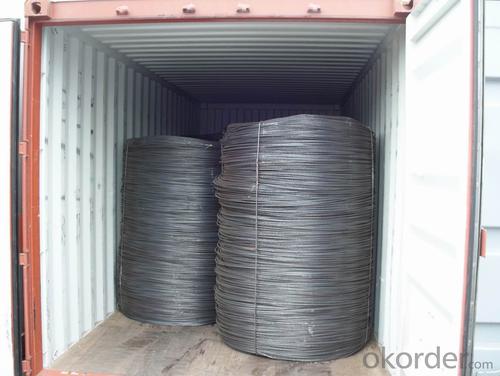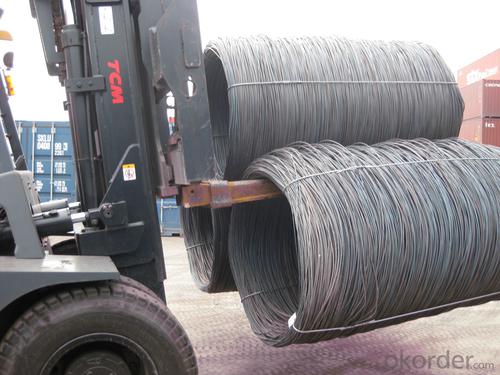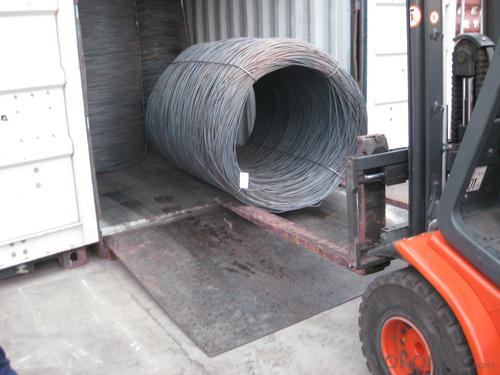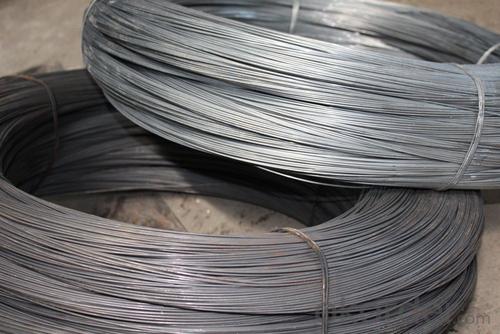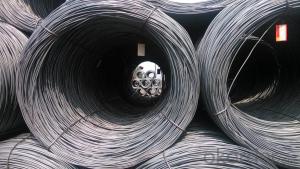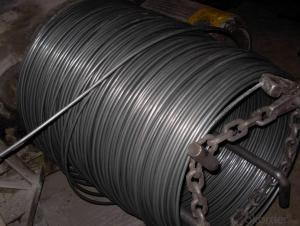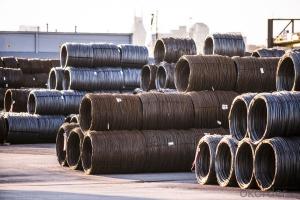SAE1006Cr Carbon Steel Wire Rod 10mm for Welding
- Loading Port:
- Shanghai
- Payment Terms:
- TT OR LC
- Min Order Qty:
- 100 m.t
- Supply Capability:
- 30000 m.t/month
OKorder Service Pledge
OKorder Financial Service
You Might Also Like
Specification
Description of SAE1006Cr Carbon Steel Wire Rod 10mm for Welding:
OKorder is offering Color Coated Steel Coil Prepainted Steel Coil at great prices with worldwide shipping. Our supplier is a world-class manufacturer of steel, with our products utilized the world over. OKorder annually supplies products to European, North American and Asian markets. We provide quotations within 24 hours of receiving an inquiry and guarantee competitive prices.
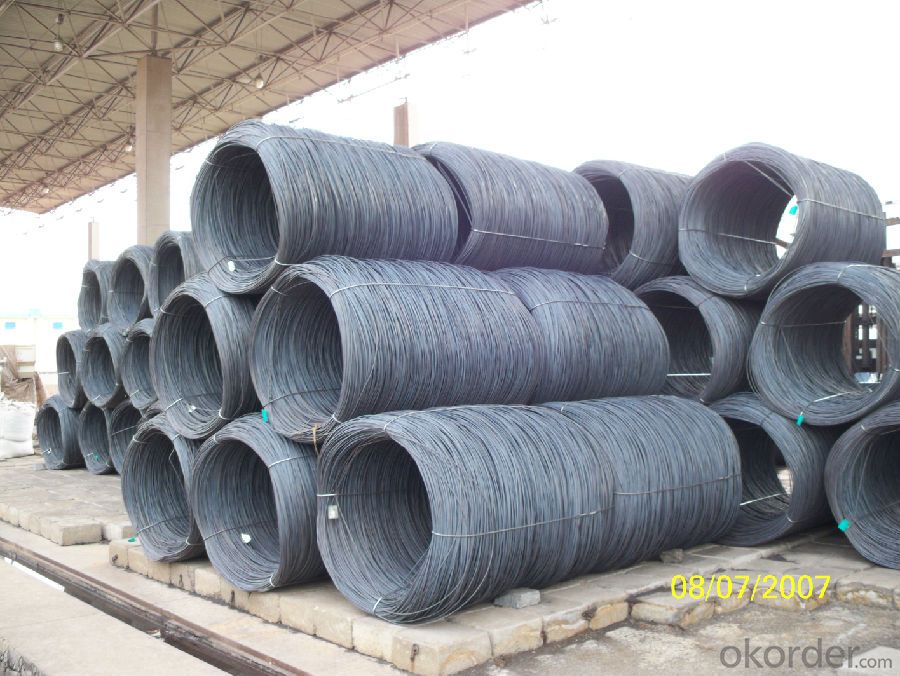
Applications of SAE1006Cr Carbon Steel Wire Rod 10mm for Welding:
Color Coated Steel Coil Prepainted Steel Coil are ideal for structural applications and are widely used in the construction of buildings and bridges, and the manufacturing, petrochemical, and transportation industries.
Main Product Features of SAE1006Cr Carbon Steel Wire Rod 10mm for Welding:
· Premium quality
· Prompt delivery & seaworthy packing (30 days after receiving deposit)
· Corrosion resistance
· Can be recycled and reused
· Mill test certification
· Professional Service
· Competitive pricing
Specifications of SAE1006Cr Carbon Steel Wire Rod 10mm for Welding:
PPGI:
1, Introduction: Color coated steel coils(sheets), i. E. PPGI, also called prepainted steel coils(sheets), are made of galvanized steel coils(sheets) with polymer coatings as surface. It's a new enclosure material and building board with characteristics of light-weighted, heat preserved&insulated, easily installed with bright colors.
2, Production Process: Pretreatment(Degreasing)_Drying_Chromating_Paint Basic Oil_Cooling_Drying_Color Coating_Cooling_Film-covering_Rolling Up
3, Characteristics:
Good at corrosion resistence. Besides zinc coating of the basic plate of galvanized steel sheet, the color coating as the surface has double lifetime to ensure better anticorrosion effect.
With excellent cold bending molded manufacturablity, PPGI products can be processed or directly used as final product. As being light-weighted and conveniently transported, they're widly used to replace wood to save energy.
4.There're thousands of colors can be chosen as per different application. Any color plays well in decoration.
No pollution with high recycling rate, PPGI coils and sheets are strongly recommended as enviroment-friendly products by the government.
5, eye bands and 4 circumferential bands in steel, galvanized metal fluted rings on inner and outer edges, galvanized.
| commodity | SAE1006Cr Carbon Steel Wire Rod 10mm for Welding |
| Techinical Standard: | JIS G3302-1998, EN10142/10137, ASTM A755 |
| grade | Q195,Q215,Q235,SAE1006,SAE1008 SAE1006Cr |
| Types: | Mesh welding |
| Base metal | galvanized, galvalume, cold rolled steel |
| Thickness | 0.14-1.0mm(0.16-0.8mm is the most advantage thickness) |
| Width | 610/724/820/914/1000/1200/1219/1220/1250mm |
| Type of coating: | PE, SMP, PVDF |
| Zinc coating | Z60-150g/m2 or AZ40-100g/m2 |
| Top painting: | 5 mic. Primer + 15 mc. R. M. P. |
| Back painting: | 5-7 mic. EP |
| Color: | According to RAL standard |
| ID coil | 508mm610mm |
| Coil weight: | 2--3MT |
| Package: | Properly packed for ocean freight exportation in 20'containers |
| Application: | Industrial panels, roofing and siding for painting/automobile |
| Price terms | FOB, CFR, CIF |
| Payment terms | 20%TT in advance+80% TT or irrevocable 80%L/C at sight |
| delivery time | 25 days after recepit of 20% TT |
| Remarks | Insurance is all risks |
| MTC 3.1 will be handed on with shipping documents | |
| We accept SGS certificatation test |
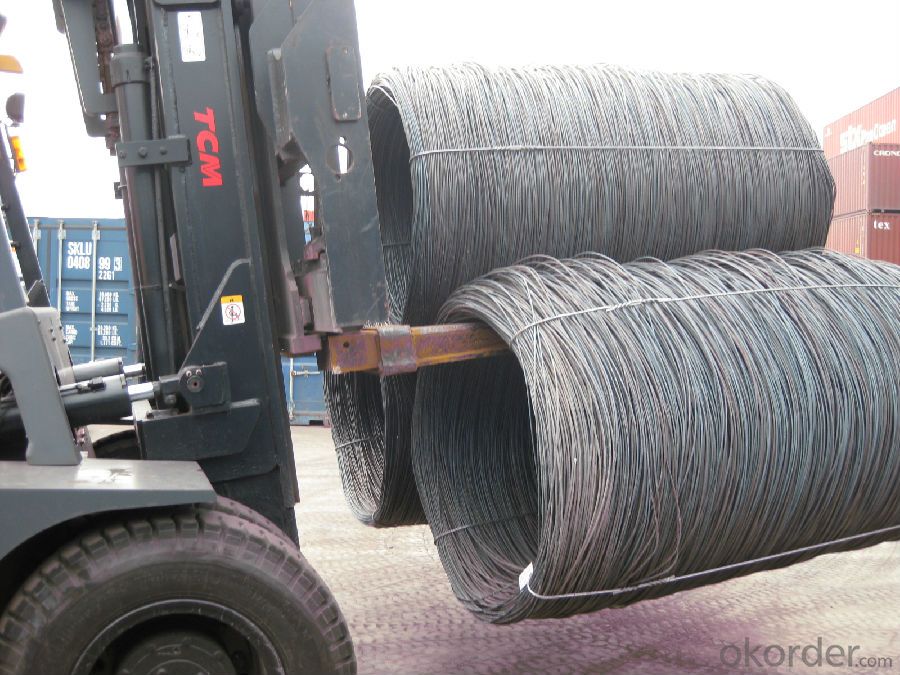
FAQ of SAE1006Cr Carbon Steel Wire Rod 10mm for Welding:
Q1: Why buy Materials & Equipment from OKorder.com?
A1: All products offered byOKorder.com are carefully selected from China's most reliable manufacturing enterprises. Through its ISO certifications, OKorder.com adheres to the highest standards and a commitment to supply chain safety and customer satisfaction.
Q2: How do we guarantee the quality of our products?
A2: We have established an advanced quality management system which conducts strict quality tests at every step, from raw materials to the final product. At the same time, we provide extensive follow-up service assurances as required.
Q3: How soon can we receive the product after purchase?
A3: Within three days of placing an order, we will begin production. The specific shipping date is dependent upon international and government factors, but is typically 7 to 10 workdays.
Q4: What makes stainless steel stainless?
A4: Stainless steel must contain at least 10.5 % chromium. It is this element that reacts with the oxygen in the air to form a complex chrome-oxide surface layer that is invisible but strong enough to prevent further oxygen from "staining" (rusting) the surface. Higher levels of chromium and the addition of other alloying elements such as nickel and molybdenum enhance this surface layer and improve the corrosion resistance of the stainless material.
Q5: Can stainless steel rust?
A5: Stainless does not "rust" as you think of regular steel rusting with a red oxide on the surface that flakes off. If you see red rust it is probably due to some iron particles that have contaminated the surface of the stainless steel and it is these iron particles that are rusting. Look at the source of the rusting and see if you can remove it from the surface.
- Q: How does the ductility of steel wire rod vary with different wire drawing processes?
- The ductility of steel wire rod can vary with different wire drawing processes. Wire drawing is a metalworking process where a metal wire is pulled through a die to reduce its diameter and increase its length. The ductility of the steel wire rod refers to its ability to deform under tensile stress without breaking. Different wire drawing processes can affect the ductility of the steel wire rod due to various factors such as the amount of reduction in diameter, the number of drawing passes, and the temperature during the process. Generally, as the diameter of the wire reduces during the wire drawing process, the ductility of the steel wire rod increases. This is because reducing the diameter increases the dislocation density in the crystal lattice of the steel, allowing for more plastic deformation before fracture. The number of drawing passes can also impact the ductility of the steel wire rod. Multiple drawing passes allow for a more controlled reduction in diameter, leading to a more uniform distribution of dislocations and an increase in ductility. Additionally, the temperature during the wire drawing process can affect the ductility of the steel wire rod. Higher temperatures can improve the ductility by reducing the strength of the steel, allowing for more deformation before fracture. However, excessive heat can also negatively impact the microstructure of the steel and reduce its ductility. In conclusion, the ductility of steel wire rod can vary with different wire drawing processes. Factors such as the amount of reduction in diameter, the number of drawing passes, and the temperature during the process all play a role in determining the final ductility of the wire.
- Q: What are the common sizes of steel wire rod?
- The size of steel wire rods differs depending on the specific application and industry requirements. However, there are commonly utilized sizes of steel wire rods with diameters ranging from 5.5mm to 20mm. These sizes are typically employed in the production of various items, including wire ropes, springs, nails, screws, and reinforcement bars for construction purposes. Moreover, steel wire rods can also be found in larger diameters that exceed 20mm, which are suitable for heavy-duty applications such as prestressed concrete structures and suspension bridges. It is worth noting that the sizes of steel wire rods can vary by region and industry standards, so it is advisable to refer to the relevant specifications and standards for accurate information.
- Q: What are the common documentation requirements for steel wire rod?
- The common documentation requirements for steel wire rod typically include the mill test certificate, which provides information about the chemical composition, mechanical properties, and dimensions of the product. Other commonly required documents include the packing list, commercial invoice, bill of lading, and certificate of origin. These documents are essential for ensuring the quality, compliance, and traceability of steel wire rod in various industries.
- Q: How is steel wire rod used in the manufacturing of wire grilles?
- Steel wire rod is used in the manufacturing of wire grilles as the main material for the wires that form the grilles. The wire rod is first drawn into the desired thickness and shape and then woven or welded together to create the wire grille. The strength and durability of the steel wire rod make it ideal for withstanding the rigors of everyday use, providing stability and security to the wire grilles.
- Q: What are the main factors affecting the customer satisfaction with steel wire rod?
- The main factors affecting customer satisfaction with steel wire rod include product quality, consistency, durability, price, timely delivery, customer service, and overall value for money.
- Q: How are steel wire rods used in the manufacturing of wire brushes for cleaning purposes?
- Steel wire rods are an essential component in the manufacturing of wire brushes for cleaning purposes. These wire rods are typically made from high-quality steel, known for its strength, durability, and flexibility. To create wire brushes, the steel wire rods undergo a series of processes. First, the wire rods are carefully selected based on their composition and tensile strength. They are then passed through a wire drawing machine, which reduces their diameter and increases their length. This process allows for the creation of thin and long wires that are perfect for brush bristles. Once the wires are drawn, they are straightened and cut to the desired length. The lengths can vary depending on the type of brush being produced. The straightened wires are then inserted into a metal ferrule or twisted together to form a bundle, depending on the brush design. The wire bristles are then attached to a handle or base, which can be made of wood, plastic, or metal. This assembly process can be done manually or with the help of specialized machinery. The bristles are secured tightly to ensure they do not come loose during use. Steel wire rods are favored for manufacturing wire brushes due to their excellent cleaning properties. The strength and flexibility of steel allow the bristles to effectively remove dirt, grime, and debris from various surfaces. They can be used on a wide range of materials, including metal, wood, and concrete. Wire brushes made from steel wire rods are commonly used for cleaning applications such as removing rust, paint, or corrosion from surfaces, preparing surfaces for painting or welding, cleaning welding joints, and scrubbing hard-to-reach areas. They are also utilized in industries such as automotive, manufacturing, construction, and maintenance. In summary, steel wire rods play a crucial role in the manufacturing of wire brushes for cleaning purposes. Their strength, durability, and flexibility make them ideal for creating effective and reliable cleaning tools. Whether it's for removing rust, cleaning welds, or scrubbing surfaces, wire brushes made from steel wire rods are an essential tool in many industries and households.
- Q: What are the different types of steel wire rod coatings used for lubrication?
- There are several different types of steel wire rod coatings used for lubrication, each with its own unique properties and benefits. Some of the most commonly used coatings include: 1. Zinc Coating: Zinc coatings are widely used for lubrication purposes as they provide excellent corrosion resistance. The zinc coating acts as a sacrificial layer, protecting the underlying steel wire rod from rust and other forms of corrosion. Additionally, zinc coatings can also act as a lubricant, reducing friction between the wire rod and other surfaces. 2. Phosphate Coating: Phosphate coatings are often used as pre-treatments before applying other lubricant coatings. These coatings create a layer of phosphate crystals on the wire rod's surface, which enhances the adhesion of subsequent lubricant coatings. Phosphate coatings also improve the wire rod's wear resistance and provide a smooth surface for better lubrication. 3. Polymer Coating: Polymer coatings are commonly used for lubrication purposes due to their excellent friction-reducing properties. These coatings are typically made of synthetic polymers such as polytetrafluoroethylene (PTFE) or polyamide. Polymer coatings create a low-friction surface that reduces wear and tear, increases the lifespan of the wire rod, and improves its performance in various applications. 4. Wax Coating: Wax coatings are another popular choice for lubricating steel wire rods. These coatings are typically made of natural or synthetic waxes and are applied by either dipping or spraying the wire rod. Wax coatings provide a protective layer that reduces friction, prevents rust, and improves the wire rod's handling during manufacturing and processing. 5. Oil Coating: Oil coatings are commonly used for temporary lubrication of steel wire rods during storage and transportation. These coatings are typically applied as a thin layer of oil that provides immediate lubrication and corrosion protection. Oil coatings are easily applied and can be removed easily before further processing or use. It is important to note that the selection of a specific coating depends on various factors, including the desired level of lubrication, corrosion resistance, and the specific application of the wire rod. Manufacturers often consider factors such as cost, performance requirements, and environmental considerations when choosing the appropriate coating for steel wire rods.
- Q: How is steel wire rod straightened after the rolling process?
- After the rolling process, steel wire rod is typically not perfectly straight. To straighten it, there are several methods that can be employed. One common method is called the straightening process, which involves passing the wire rod through a series of straightening rolls or dies. The wire rod is fed into the first set of rolls, which are typically inclined at an angle. As the rod passes through these rolls, it is bent in the opposite direction of its initial curvature. The angle of the rolls is adjusted accordingly to gradually straighten the rod. This process is repeated through multiple sets of rolls, with each subsequent set adjusting the angle slightly to further straighten the wire rod. Another method used to straighten steel wire rod is the rotary straightening process. In this method, the wire rod is passed through a series of rotating straightening rolls. These rolls are often placed at different angles to effectively straighten the rod. As the rod passes through the rolls, it is subjected to bending forces that counteract its initial curvature, resulting in a straightened wire rod. In addition to these methods, there are specialized machines and equipment available for straightening steel wire rod. These machines use various mechanisms, such as hydraulic or mechanical systems, to apply controlled bending forces to the rod and straighten it. Overall, the straightening process for steel wire rod involves applying controlled bending forces through a series of rolls or specialized machines. This helps to gradually eliminate any curvature and achieve a straightened wire rod that meets the required specifications.
- Q: How is steel wire rod used in the manufacturing of wire mesh gates?
- Steel wire rod is used in the manufacturing of wire mesh gates as the primary raw material. It is processed and formed into the desired shape to create the framework of the gate. The steel wire rod provides strength, durability, and stability to the gate, ensuring it can withstand various external forces and retain its shape over time.
- Q: What are the different types of steel wire rod coatings used for improved wear resistance?
- There are several types of steel wire rod coatings used for improved wear resistance. Some of the commonly used coatings include zinc, galvanized, zinc-aluminum, and epoxy coatings. Each of these coatings provides different levels of protection against wear and corrosion, depending on the specific application and requirements.
Send your message to us
SAE1006Cr Carbon Steel Wire Rod 10mm for Welding
- Loading Port:
- Shanghai
- Payment Terms:
- TT OR LC
- Min Order Qty:
- 100 m.t
- Supply Capability:
- 30000 m.t/month
OKorder Service Pledge
OKorder Financial Service
Similar products
Hot products
Hot Searches
Related keywords

